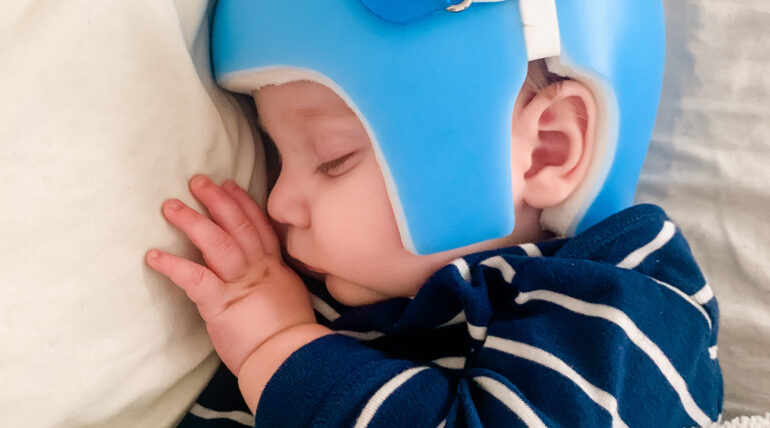Every week, the Cranial Center of New Jersey receives email and social media questions about cranial helmets, “flat-head syndrome,” and other questions. Today, cranial orthosis questions were answered by Cranial Center staff members. So here we go.
What is deformational Plagiocephaly?
Deformational Plagiocephaly is characterized by unusual flattening of an infant’s head, and a prominent or flattened forehead is often visible. Plagiocephaly exhibits various head shapes, including flattening on one side of the back of the head with an asymmetric forehead and brachycephalic head shapes that are flat across the entire back of the head with very prominent foreheads.
Is deformational Plagiocephaly more common than it used to be?
The incidence of deformational plagiocephaly has increased since 1992, when the American Academy of Pediatrics recommended that parents place infants on their backs or sides to sleep in order to prevent Sudden Infant Death Syndrome. This highly effective program has dropped the SIDS rate in the United States and worldwide by 40%.
However, the additional time many infants spend in infant seats, car seats, and other supine (back) positions places them at risk of developing greater flatness and/or asymmetrically shaped heads. But this program alone is not responsible for the increased incidence. Other factors that may influence the development of deformational plagiocephaly include premature births, restrictive intrauterine positioning, cervical spinal abnormalities, and/or birth trauma.
Deformational plagiocephaly is commonly seen in multiple births, affecting one or more siblings. As many as 85% of the infants with deformational plagiocephaly also have torticollis. This condition is caused by tightness or weakness on one side of the sternocleidomastoid muscle in the neck. When one side of this muscle is shortened, the infant’s head bends forward, tilts toward the shoulder on the affected side, and the face rotates toward the opposite shoulder.
This muscle tightness or imbalance causes the head to rest consistently in the same position, creating areas of flatness on the back of the skull and compensatory growth in other areas of the head. Physical therapy is often prescribed to address torticollis. Home programs for stretching and massage of the affected muscle are very successful in addressing this problem.
What if my pediatrician tells me that my infant’s head shape will correct on its own?
Historically, many head shape deformities present at birth disappeared within about 6 weeks because babies were placed in a number of different positions during the day and slept on their tummies at night. Since the Back to Sleep program was initiated in 1992, these head shape deformities often persist because babies sleep on their back all night and spend extended time on their backs during the day in infant carriers, swings, car seats, etc.
Parents must be vigilant about changing the infant’s position more than in any other period of child rearing. Babies that spend most of their time on their backs in the early months roll and crawl later than usual, which results in even more time before the infant is able to actively reposition themselves.
The best way to help your infant’s head correct “on its own” is to place your infant in a variety of positions during the time your infant is awake and supervised. This will encourage your infant to actively move their head through a full range of motion, strengthen their neck, shoulder and trunk muscles, and minimize pressure on the back of the head.
More suggested repositioning activities are available in “Tummy Time Tools”, a document that can be downloaded from Orthomerica’s website. It is possible that your efforts to reposition your infant will be rewarded with a more symmetrical head shape that does not require further intervention.
However, if your infant’s head does not change after two months of alternate positioning, make sure your pediatrician understands that you have tried prone and other positions to help make the infant’s head more symmetrical, and the skull has not corrected. Then ask your pediatrician if your infant would benefit from a cranial remolding orthosis, and/or request a referral to a craniofacial specialist.


